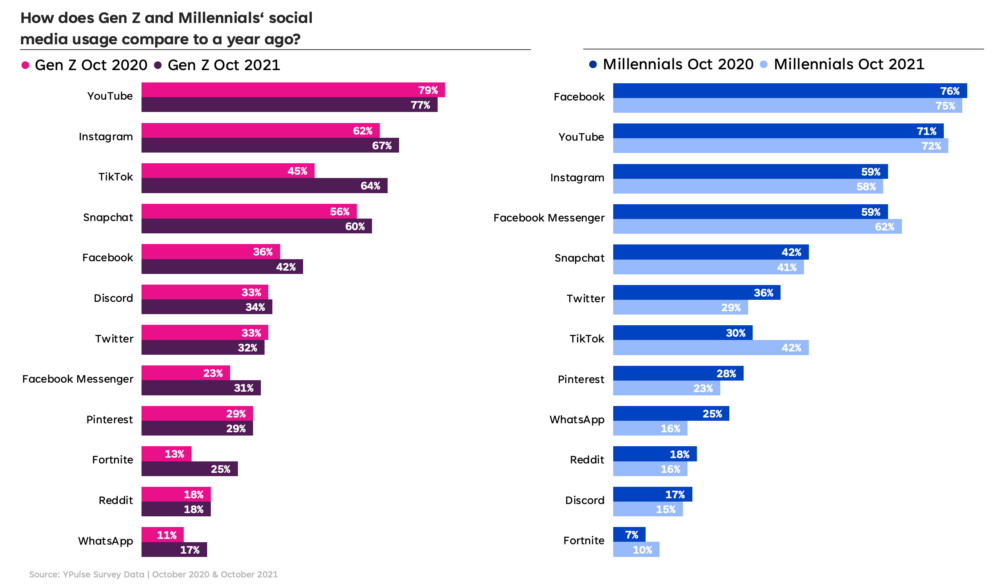More than half of the nation’s total population is now made up of millennials and Generation Z. When combined, these two generations number 166 million as of July 2019, or 50.7% of the nation’s population. That means they now outnumber Gen X, Baby Boomers, and the Silent Generation.
Only a couple years ago, it was common knowledge that Generation Z (Gen Z) and Millennials (Gen Y) are highly different. While Gen Z is perceived as more entrepreneurial , focused more on saving and constantly craving innovations from brands, Millennials were seen as more committed to their favorite brands and jobs.
But the past years dealing with a global pandemic has given us a new perspective on their consumer behaviors. People from both generations are highly connected to technology and the Internet and tend to spend the majority of their time online. Despite the significant similarities, there is still some divergence in their behaviors.
It is important for brands and retailers to understand the nuances and personality of each generation so they can cater their products and services to them more effectively.
What is the Millennial age range?
According to the Pew Research Center, Millennials include people born between 1981 and 1996. This means that in 2022, Millennials are 27 to 42 years old.
What is the Gen Z age range?
Members of Gen Z are those born between 1997 and 2015. In 2023, Gen Z will be 8 to 26 years old. The biggest difference between the two generations is the age gap. The oldest of the Millennial generation are in their early 40s, while the youngest of generation Z are still in grade school and college. It will be interesting to see how their preferences and shopping habits evolve when the entire group is earning and spending its own money.
The differences between Millennial and Gen Z?
Millennials and Generation Z are different in how they shop, interact with brand
Gen Z prefer shopping on their mobile devices, while Millennials are more traditional

As of recent, both generations are immensely connected to the internet and social networks. While Millennials witnessed the growth of the Internet, Gen Z were exposed to technology at a very young age.
Every day, Millennials spend about 7.5 hours while Gen Z spend nearly 10 hours a day on the Internet. According to Think With Google, Gen Z significantly spend a lot of time surfing the internet on their smartphones, of which about 71% of Gen Z teenagers use mobile devices to watch videos.
In addition, social commerce has become increasingly popular in recent years and is predicted to become increasingly prevalent in the upcoming years. Gen Z enjoys social shopping, with 64% using Instagram, Facebook, and other social platforms to browse and make purchases, and 41% shopping through social influencers. Millennials are less enthusiastic about these channels, with 58% social shopping and just 32% shopping through influencers.
Different usage of social media platforms

While millennials prefer platforms like Facebook, Instagram, LinkedIn, Twitter, Gen Z prefer platforms that mainly post and share videos like Instagram, YouTube, Snapchat or most recently with skyrocketing popularity, TikTok.
One of the most frequently used platforms by both generations is Instagram – one of the apps that laid the groundwork for creative video and photo sharing. While Instagram has been around for a long time compared to apps like TikTok or Snapchat, the platform’s innovative features still appeal to Millennials and Generation Z members who love creating and sharing their own content, which fosters the popularity of user-generated content (UGC).
YouTube is also a prominent social network favored by both Millennials and Gen Z, as the video platform is the second most used search engine. The video platform is also the second-most used search engine and a platform where many in Gen Z and millennial generations go for product research. So, if you want to attract more Millennials and Gen Z consumers, businesses need to strategize to produce creative short videos so that customers can experience the most vivid images as quickly as possible.
Gen Z prioritize convenience and fast delivery
When it comes to customer experience, gen Z prefers immediate support and services. Since they grow up alongside the on-demand economy, efficiency is at the top of their mind when it comes to making purchase decisions.
“Gen Z and millennials are changing the future of shopping where convenience and faster delivery hold prominence in choosing their online shopping destinations. An average Gen Z shopper scans four sites before choosing the final shopping destination, and the journey (faster checkouts) is as important as the destination (faster delivery).” says Rachna Prasad, chief of marketing, Vinculum group, an omnichannel retail e-commerce software solutions provider.
It’s not surprising, then, that 76% of Gen Z prefer convenience over brand compared to 70% of Millennials. According to Salesforce research, 27% of Gen Z prefer to have their groceries delivered within an hour, and 23% want their alcohol within that same timeframe. This drops to 12% and 11%, respectively, for Millennials.
Gen Z prefers a personalized shopping experience, while Millennials appreciate loyalty programs
According to Deloitte’s 2015 consumer report Made-to-order, the need for personalization is on the rise: 1 in 4 Gen Z “are willing for businesses to use their information to deliver products.” or more personalized service”. Furthermore, OC&C Strategy Consultants says 25% of Gen Z consumers say it’s important to have a unique perspective on style and creativity. aTherefore, they suggest retailers focus on personalized services and distinct experiences.
On the other hand, Millennials show more interest in loyalty programs, however, with 61% claiming membership in at least one. Loyalty programs aren’t a big draw for Gen Z, with only 45% enrolled. This could offer future opportunities to brands and retailers, as long as the programs they develop are easy to understand and use.
Simpler terms and conditions were favored by 48% of Gen Z, and 57% said they could be persuaded to join loyalty programs if rewards were automatically applied, and 62% said they were more likely to join a loyalty program if the rewards were personalized.
Selling across the generations
Despite all the “Millennials vs. Gen Z” discussion, brands still need to build greater trust with both generations. How? By using data to understand what matters most to them, then personalizing offerings that meet their wants and needs.
Both generations grew up in a world filled with advice: don’t trust the surface. Therefore, they highly value the transparency and honesty of the brand. This generation is more wary and skeptical of traditional marketing activities than the previous generation. If they feel that they are being “for sale”, they will most likely get annoyed and start to withdraw.
Therefore, businesses need to place authenticity and customer’s interest at the center of their marketing campaigns. Companies that focus on consistently providing high-quality content – aligned with customer needs – may see an increase in repeat visits and user engagement.
To build a lifetime of loyalty, brands need to make every interaction custom and unique, offering both generations products, services, promotions and rewards that speak to their evolving shopping habits and innate individualism.
If you find this article helpful, check out our blogs and articles on how to create effective small business marketing in 2023 and other insights here.




